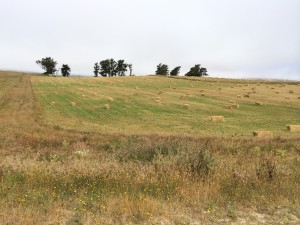Our Pos/Neg fencing had arrived! Excited, I set it all up, with the help of a highschool intern, Dylan, who had been helping on the farm for 2 weeks. We put this fencing up in a different spot (less dry/rocky soil than the previous test site) between the creamery and the farm house, and put some babies inside to test it. We figured that since there was a large tree in the test site, any adult goats might damage it.
It ended up working well! The two ground rods created a high enough current to provide enough shock to keep the babies in (with the exception of Rafiki who often escaped, but returned). This was really exciting for me, because it meant that in the future (probably once I was back at school), Dylan and Hadley would be ready to move this fencing around on our hay field beyond the pastures. We’d been dreaming of this hay field becoming a pasture all summer long, since it was pretty much the only green land left on the property! However we wanted to wait until there was sufficient regrowth, and until we were comfortable with the fencing system to begin MIG. I believe that Dylan actually started doing this in September.
My final project at Toluma was getting their hay tested (nutrients, ash etc…). Over the summer, I became a “Certified Hay Sampler” online, and ordered the Penn State Probe tool for testing. Only on my last day on the farm did I actually have time to complete the testing! This consisted of taking random probe samples from around 40 bales (attaching a drill to the probe and filling up plastic bags with the contents), and sending the combined sample to the UC Davis Analytical Lab. For sampling, I created a random number generator and counted along the faces of the stacks of bales to pick the specific bales for sampling.




Speak Your Mind